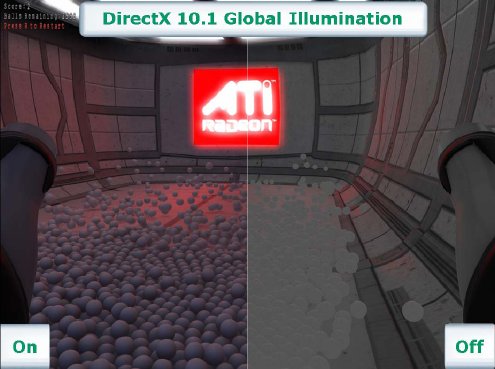
This is one of the features AMD will be hammering on. The new GeForce 8800 GT doesn't have DX10.1 support so AMD will do its best to convince everyone that DX10.1 is really a must-have feature.
One of the first things the document confirms is that the new ATI graphics card series will be called Radeon HD 3800 series. The firm hasn't confirmed the name of the RV670 yet but we believe it will be Radeon HD 3850 and that the cards will be launched on November 15th. According to the memo the Radeon HD 3800 series will feature a power efficient 55nm design, with PCI Express 2.0, UVD and hardware accelerated tessellation support.
The document also outlines some of the key features of Microsoft's upcoming DirectX 10.1 update which will add new shading and texturing capabilities, anti-aliasing improvements and tighter specifications.
Here's an overview of the new DX10.1 features:
|
DirectX 10.1's new features |
||
| Feature | Function | Benefits |
| Shader and texture improvements | ||
| Cube Map Arrays | Allow reading and writing of multiple cube maps in a single rendering pass | Efficient global illumination in real time for complex, dynamic, interface scenes. Enable many ray trace quality effects including indirect lighting, color bleeding, soft shadows, refraction and high quality glossy reflections |
| Separate Blend Modes per-MRT | Allows pixel shaders to output to multiple buffers (MRTs) - each with their own blend mode | Efficient Deferred Rendering for improved performance in complex 3D scenes |
| Increased Vertex Shader Inputs & Outputs | Doubled from 16 to 32 128-bit values per share | Improved performance for complex shaders |
| Gather4 | Allows a 2x2 block of unfiltered texture values to be fetched in place of a single bilinear filtered texture lookup | Improved performance for Stream Computing applications |
| LOD instruction | New shader instruction that returns the level of detail for a filtered texture lookup | Custom texture filtering techniques for optimized performance and quality |
| Improved Anti-Aliasing | ||
| Multi-sample buffer reads and writes | Allow individual color and depth samples in a multi-sample buffer to be accessed directly by a shader | Custome edge detect filters for high quality anti-aliasing with optimized performance. Improved adaptive anti-aliasing perfoprmance. Improved compatibility of anti-aliasing quality with HDR rendering. Improved anti-aliasing compatibility and performance with deferred rendering techniques. |
| Pixel Coverage Masks | Enables programmable AA in a pixel shader | |
| Programmable AA Sample Patterns | Gives programmers control over individual sample locations for each pixel | Temporal anti-aliasing. Improved image quality for multi-GPU anti-aliasing techniques. |
| Tighter specifications | ||
| FP32 filtering required | Filtering of 128-bit floating point texture formats now a requirement instead of optional feature | Encourages use of these high precision data formats by ensuring HW compatibility. |
| Int16 blending requires | Blending of 64-bit integer pixel format now required instead of option feature | |
| Minimum 4x MSAA support required | Multi-sample anti-aliasing with at least 4 samples per pixel must be supported for all 32-bit and 64-bit pixel formats | Ensures AA can behave identically on all DX 10.1 GPUs. Encourages support for AA by improving consistency |
| Standardized AA sample patterns | Pre-defined sample locations for 2x, 4x, 8x, and 16xx modes that hardware must support | |
| Increased precision for floating point operations | 0.5 ULP precision required for all floating point math (add/subtract/multiply/divide) and blending operations | Eliminates rounding errors. Matches IEEE standard requirements for these operations. |
